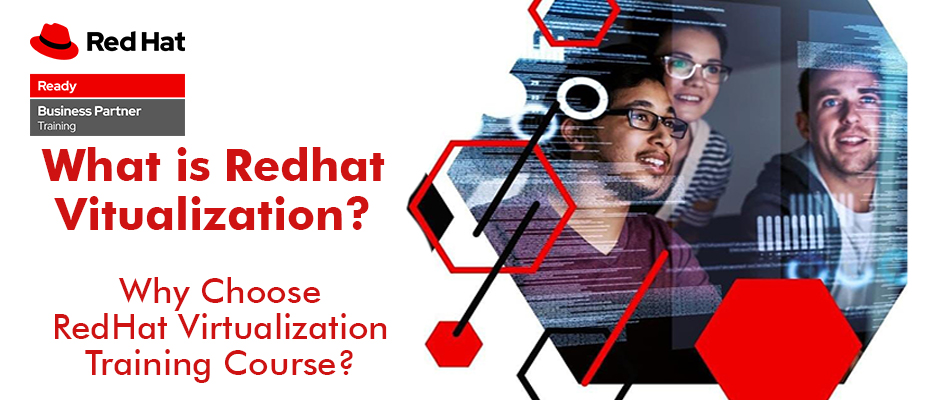Everyone who is a part of the tech world is aware of Red Hat and how this company is changing the face of the entire sector. Red Hat is amongst the world’s leading providers of enterprise open- source solutions that include Linux, Kubernetes, container and cloud. It has been making it more efficient for enterprises to be able to work across multiple platforms and within various environments.
As more companies and organizations begin to imbibe Red Hat in their everyday working, the need for expert individuals in witnessing a rise too. But amid the dozens of certifications that Red Hat has to offer, which one should you be going for and why?
This blog will take you on a journey to uncover what is Red Hat Virtualization and why choose Red Hat Virtualization training course for a successful run to your career. On the way, we will be finding out answers to many more related questions and do our best to ensure that by the time you are done reading this blog, you have a more cemented view about the career path you should be taking.
Let’s take one step at a time to understand Red Hat Virtualization a bit better.
What is Virtualization?
Virtualization is the technology allowing the user to create varied dedicated resources or stimulated environments from a single or one physical hardware system. Hypervisor, a software, is connected to the hardware and enables the user to split one system into distinct, secure and separate environments, which are called Virtual Machines or VMs.
These virtual machines are dependent on the hypervisor’s ability for the separation of the machine’s resources from the hardware as well as to distribute them appropriately. Thus, Virtualization aids in getting the optimum value from one’s previous investments.
The physical hardware which is equipped with a hypervisor is known as the host. On the other hand, the various VMs that utilise its resources are known as guests.
Computing resources as storage, CPU and memory are treated as a pool of resources which can efficiently be relocated by these guests. Guests can receive the resources as and when they need because the operators have the power to control the virtual instances of storage, CPU, memory and other resources.
Thus, we can say that Virtualization is the technology with which we can create suitable IT services by employing the resources which, in traditional cases, are bound to hardware. It shows us the way to consume a physical machine’ optimum capacity by segregating and separating its capabilities amongst multiple environments or users.
The History of Virtualization – A Peek
The first knowledge of Virtualization can be traced back to the 1960s. however, it was not until the early 2000s that Virtualization came fully into use and widely adopted. Technologies such as hypervisor that enable Virtualization were developed and started functioning decades ago and have enabled giving various users simultaneous admittance to computers that executed batch processing.
Batch processing was a widely used computing style within the business sector. It helped in running routine tasks hundreds and thousands of times rapidly.
It is in the 1990s that companies found their physical hardware being largely underused as each server was only able to run one vendor-specific task. With every problem, comes a solution and in this case, it was Virtualization.
It was Virtualization that cam ahead as the answer to two major problems. One – companies could now run legacy apps on various OS (operating systems) versions and types. Two – companies could now partition their servers. This ensured that either the servers were being fully utilised or not at all.
This widespread applicability of Virtualization aided in reducing the vendor lock-in, making it the foundation of cloud computing.
What is Red Hat Virtualization?
Red Hat Virtualization, which is officially known as RH318 is a course that gets you trained in the specificities that will help you gain the aptitude expected to work, send and administer virtual machines in your work expecting utilizing Red Hat Virtualization. This Red Hat Virtualization training course includes you working on live projects to gain hands-on knowledge to be able to learn to send and arrange the Red Hat Virtualization foundation as well as to use it in arranging and overseeing virtual machines.
The course is dependent on Red Hat enterprise Virtualization 4.3, Red Hat Hyperconverged Infrastructure for Virtualization 1.6 and Red Hat Enterprise Linux 7.6 and 8.
How does Virtualization Work?
To better understand Virtualization, you need to know more about the working that goes being the Virtualization.
Hypervisors are software that separates the virtual environments from the physical resources. Hypervisors can be installed directly onto hardware or can sit on the top of an OS. Hypervisors take up physical resources and then segregate them so as to be used by virtual environments.
What are the Types of Virtualizations?
The main types of Virtualizations include –
-
Data Virtualization –
Data Virtualization gives companies the advantage of treating data as a dynamic supply – providing processing capabilities which hold the potential to bring together data from various sources, transform data as per the user needs and easily accommodate newer data sources.
Tools of Data Virtualization sit right in front of the various data sources, allowing them to be treated as one source and delivering the needed data, in the form that is required and at the needed time to any user or application.
-
Server Virtualization –
Servers are computers that are designed in such a manner so as to process high volumes of specific tasks very well so that other computers such as desktops and laptops can perform a variety of other tasks.
When a server is Virtualized, it performs more specific functions that involves partitioning to. Hence, components can be employed to serve multiple functions.
-
Network Functions Virtualization –
Network functions Virtualization, also known as NFV is used to separate a certain network’s key functions such as IP configuration, file sharing, directory services, etc. so as to distribute them amongst the environments. Once the software functions become independent of these physical machines, certain functions have the advantage of being packaged together into a new network and get assigned to an environment.
When a network is Virtualized, the number of physical components such as routers, hubs, switches, cables and servers, are reduced.
-
Desktop Virtualization –
Desktop Virtualization is often confused with operating system Virtualization. However, desktop Virtualization allows the user to deploy a single administrator or automated administration tool for the deployment of simulated desktop environments towards hundreds of physical machines at a single go.
While traditional desktop environments are physically updated, installed and configured on every machine, desktop Virtualization gives the admin the opportunity to perform mass security checks, updates and configuration on all the virtual desktops.
-
Operating System Virtualization –
Operating system Virtualization takes place at the kernel, which is the central task manager of all operating systems. It is the most useful way of running Windows and Linux environments simultaneously.
Companies can also instil virtual OS to computers, which will lead to the reduction of bulk hardware cost because computers do not require such high capabilities. It will also lead to an increase in the security as all the virtual instances can be isolated and monitored. The time spent on various IT services as such software updates can also be limited.
Who is this Red Hat Virtualization Course Most Suitable for?
If you are someone with a tech background, then you are definitely eligible to get started in a red hat course. However, to be able to become a Red Hat Virtualization expert, you need to clear the following criteria –
- If you are a System Administrator from another platform, then you can pursue this course.
- If you are a Linux System Administrator who is seeking the responsibility or is already responsible for managing and implementing Virtualization infrastructures, then this is the course for you to be able to expand your horizons.
- If you are a Red Hat Certified Engineer (RHCE) and are looking for the right opportunity to become a Red Hat Certified Architect (RHCA).
What are the Prerequisites to This Course?
To qualify for this Red Hat Virtualization course, there are not many prerequisites that you need to clear.
- You should have prior experience in using red hat Enterprise Virtualization.
- You need to become a RHCA (Red Hat Certified Administrator) or you need to demonstrate equivalent experience.
Why Choose Red Hat Virtualization Training Course by Grras Solutions?
Grras Solutions is a name you must have heard of on your journey to find out more about the course as well as to get started with it. When it comes to getting trained and certified, the one name which has proven itself to be the best is none other than Grras Solutions.
After having been in the sector for more than 14 years, Grras Solutions has become synonymous with quality training and amazing opportunities. The kind of exposure you get here is incredible. Here are some of the top reasons as to why you should choose Red Hat Virtualization training course by Grras Solutions.
- While the course remains roughly the same, it is how that course is taught that changes. At Grras Solutions, you will find yourself surrounded by industry experts as your trainers and the benefits that come along are simply wonderful.
- Additional classes to help you enhance your personality, polish your soft skills and gain more confidence is just a regular benefit at Grras Solutions. You also get the chance to work on your interview preparation skills as well as learn the right way to make an impactful resume.
- With both online and offline classes to choose from, you have the opportunity to learn on the go or learn face-to-face. The choice is yours to make and both are equally good.
Conclusion
The list of reasons as to why you should be going with Red Hat Virtualization are many. Similarly, the list of reasons stating why you should choose Grras Solutions are many too. And sharing this line of similarity is also how great the two are and the kind of market they have made for themselves.
So, what is the wait for now? You now know what is Red Hat Virtualization and why choose Red Hat Virtualization training course by Grras Solutions. Get started with it today to get the path to success.






